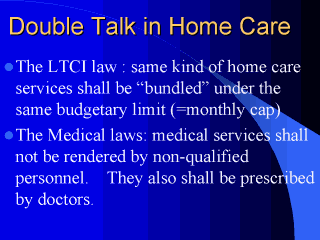| front |1 |2 |3 |4 |5 |6 |7 |8 |9 |10 |11 |12 |13 |14 |15 |16 |17 |18 |19 |20 |21 |22 |23 |24 |25 |26 |27 |28 |29 |30 |31 |32 |33 |34 |35 |36 |review |
 |
As for home care, a
recipient can receive both medical and non-medical services within the monthly budgetary
cap [beyond the budget, the LTCI will not pay the provider and the recipient will be
personally liable for any charge incurred]. Ironically enough, although both medical and non-medical services are bundled in the same budgetary cap, legal boundaries between the two still remains subjecting the medical services to more legal restrictions than non-medical services. For example, medical services may be rendered only by qualified professionals such as nurses or PTs and must also be prescribed by doctors. Home helpers can provide the services with the order from the recipient, but visiting nurses can not provide their professional services without prescriptions by doctors. These restrictions place medical services such as visiting nursing services at a considerable disadvantage over the non-medical services such as home help in the competitive market as will be discussed later. |